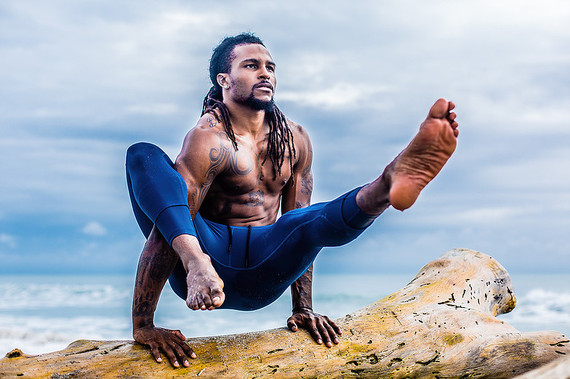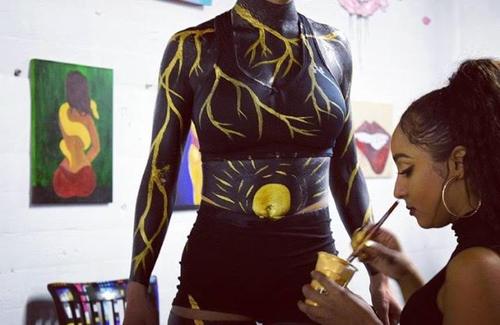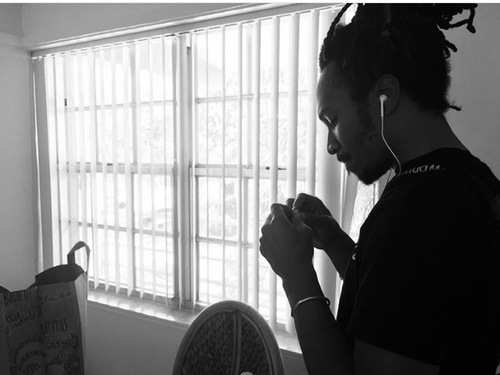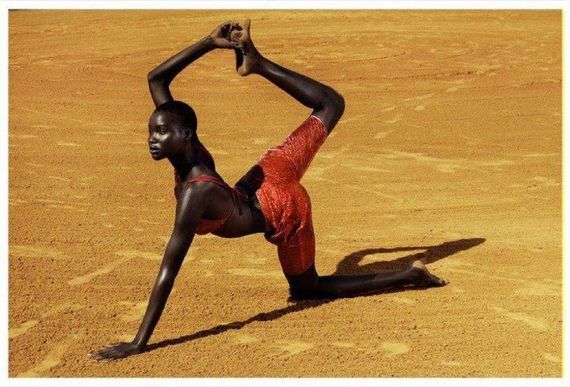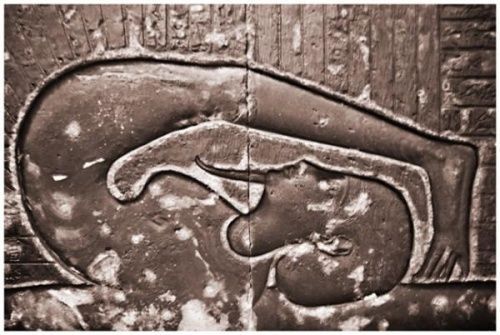It was a sizzling hot April evening on the North East side of Atlanta, Georgia. About five miles from the Georgia Dome there was a line that stretched out eight blocks on Sheldon Avenue as hundreds of diverse faces patiently waited to enter the Artlanta Gallery. Owned by Tyree Smith, the spacious gallery is the epicenter of Atlanta's growing renaissance movement catering to the city most thriving urban-centered artists. The streets were so packed, you would have thought people were waiting to see Future perform but instead they were waiting to enter the gallery for the highly anticipated yoga and art show entitled Moving Art ATL. Some had even flown in from New York, Miami and Chicago to catch the experience. Beautifully brown earthy couples with afros and locks mingled outside with Barbie blonde valley girls taking selfies while hanging on to their punk rock-Kurt Cobain-esqu skater boyfriends. The eclectic mix of people waiting to attend the anniversary of Moving Art was a beautiful representation of Atlanta's progressive and blended melting pot. Hip hop music blared out of Range Rovers and Lexus trucks with the top down as tunes from Floetry, Jill Scott and Lauryn Hill echoed through Eco-friendly Hybrids and Toyota Priuses'. Cars circled around Sheldon Street searching for nearby parking but everything close was taken. Still, no one seemed aggravated at all. A calming energy encompassed the air as I waited to enter the Artlanta Gallery not knowing what to expect. From the videos I had seen on Instagram coupled with the energy outside of the gallery, it was evident that the person who conceived Moving Art ATL had fulfilled his mission to unify people through the arts and to enable artists to find their center while fulfilling the actual purpose of yoga defined as; "managing the state of imbalance that overwhelms and creates a form of bondage in the mind."
Creating art in any form is a soul experience that requires us to be still, balanced and connected to our spirit and more importantly the source of our creativity---our creator. Art Dealer, Allen "Rome" Batty conceived Moving Art ATL around this theory. "Art is a form of self-expression but I think being balanced mentally, physically and spiritually is an important aspect of creative success for any type of artists. Balance is everything," explained Rome.
Artists often express how they internally feel inside through their work. The adrenaline rush of creative ideas bursting through the mind in high speed intervals can be so obsessively strong that to capture this rush and translate it to canvas, words or dance is both exhilarating and overwhelming. Externally, in order to create art one must be centered. A lot of artists spend 90% of their time struggling to be still enough to create. In the end without that balance, we end up creating nothing but volumes of incomplete pieces that could have become masterpieces if only we could have been still. Through Moving Art, artists are able to create while elevating their mind to a deeper consciousness filled with levels of calmness, and peace that are hard to attain when we're not still. By integrating meditation and yoga into art, Moving Art is helping their followers reduce stress and anxiety while increasing happiness and emotional stability.
"I was soul searching, when I found Yoga" begins Rome who's from Atlanta's Ben Hill neighborhood. "I had always been into art but yoga was new to me. It helped free me and center me. It got me into a new way of thinking. In our culture I think we are so driven to define ourselves through material objects and possessions. The idea of rejecting this theory as the center of my purpose inspired me. I knew that if it could help me in that way it would help a lot of people that wouldn't even consider practicing yoga. Especially people from neighborhoods like where I grew up. There are so many distractions and things that come at you while you're just trying to survive that it's hard to conceptualize that there are other ways to live life beyond the streets, pain, violence and poverty that you see outside of your window."
Incorporating the principles of yoga changed Rome's entire lifestyle and how he looked at the world. Suddenly he became more in tuned to everything around him. Compassion became a priority and elevating those around him was more than just an option. "I went to an art show and my experience there really struck something inside of me. As an Art dealer I started wondering why we didn't have the same avenues as other artists who had galleries and exhibitions freely open to them?" Rome questioned the inequities and challenges that dis-proportionally affects artists of color. On a deeper level Rome wondered how certain environments impacted the mental and emotional health of artists and how this played into the potential of their success. While chaos may fuel aspects of creativity and the blur between surrealism and reality is a thin line, the mind and body must be properly aligned in order for us to reach our highest level of potential not just professionally but personally. Furthermore, to maintain an equilibrium of peace after experiencing the peak and climax of mastering our art can be challenging. Highs and lows are as synonymous to artists as paint-brushes. Rome subscribes to the belief that balance keeps us from experiencing the patterns of extreme highs and dramatic lows that historically haunt many artistic people. Like a Physician supplying the remedies required for creative souls to flourish, Rome wanted to create a space and movement where artists could operate at their best.
"When I arrived home from the art show I had every intention of combining yoga with the visual arts." That night in the quietness of his home, Rome conceived Moving Art. He was convinced that the interrelation between yoga and art would strengthen others and help them see the light required to grow and succeed. If it worked for him it had to work for others. He envisioned a space that Artists could create, meditate, move, flow and be centered---all under one roof. It was a dream that he wouldn't prolong for too long. He connected with Yoga masters Derrick Townsel Tie-Coachmen Simpson, Dara Danielle, Renee Watkins and Bri Young Roane. Rome then recruited Artists, Ezra Ferguson, Dorvilier Oliver and a slew of other creative geniuses to transpose Moving Art from a dream to reality.
That was in 2015. One year later, Moving Art has become an Un-paralleled unique experience. It is a complete celebration of unity within the arts. The dream that Rome did not defer is becoming a national phenomenon in cities across the country such as New York, Miami and Atlanta where it all began. April 16th, 2016 marked the one year anniversary of Moving Art Atl. When I entered inside the gallery I saw the infusion of hip hop and art in motion. Imagine if Outkast and Erykah Badu put together an art-inspired event with Cee-Lo Green, Kelis, Fahamu Pecou and the Roots. The energy captured at that event would embody the feeling of Moving Art ATL. Focused live painters were bringing their art to life using the human body as canvas while Yogis and fitness teachers beautifully stretched and posed. A plethora of health conscious creative souls vibed to the music, flowing through the immensely crowded space. African inspired vendors sold Ankara wax skirts and gorgeous Chitenga printed fabrics to fashionistas ahead of the curve.I was inspired by the level of consciousness, beauty and self-love within the room.
Rome's inception of Moving Art is dramatically changing lives in a very holistic way. It has also become a sort of art therapy for young Urbanites and youth who were once lost in the system of life. Meditation over incarceration is proving to be a much more effective tool in changing behavior and transforming lives. Yoga helped Rome return to the essence and core of who he was outside of the social influences, stereotypes and expectations that are often forced upon young urban African-American men. Sometimes we become what we are told we are as opposed to who we are and can be. But we can always get back that which we may have forgotten or lost. There is an African proverb from the Akan tribe of Ghana that defines this and embodies the meaning of the word Sankofa: (San=return, Ko=go, Fa = look seek and take) This proverb states, "Se wo were fi na wosankofa a yenkyi" in translation "It is not wrong to go back for that which you have forgotten."
By having hip hop enthusiasts and melanin-rich soul survivors with an array of mahogany, caramel and ebony complexions partaking in yoga, Moving Art is considered to be breaking the stereotypes of the ancient healing practice. .This is an incorrect assessment when the historical context of yoga is considered. Sankofa comes into play here as well because the roots and elements of yoga are much more closely tied to the culture then people would think.
The word yoga itself is derived from India's Hindu religion and was named as such by Hindus. This should not be omitted. What else cannot be omitted is that the practice of utilizing breathing, stretching and meditation principals as a form of healing both emotionally and physically through alignment has been documented as part of our human social construct since the first known civilization to men.
"The Nubians who migrated up the Nile from Southern Africa all the way to Egypt and South Asia utilized breathing and stretching to center themselves for centuries," said world renown Kemetic Yoga Master and Instructor ,Yiser Ra Hotep Lawrence who has conducted 30 years of research on the practice. In fact historians and archaeologists record that the most ancient physical traces of what we now may identify as yoga were found in Africa specifically Kemet, Egypt as factually displayed through early hieroglyphics. This gave birth to what we know as Kemetic Yoga, an "ancient Egyptian system of enlightenment based upon the practice of physical movement and controlled breathing." Hotep shared, that "Kemetic people who built the pyramids and gave the world mathematics, architecture, astronomy, and medicine used symbols to express their scientific and philosophical ideas. Carved on the back of a wooden chair found in the tomb of Pharaoh Tutankhamen is the image of a man called Shu. Shu represents the concept of breath and meditation." He went on to say that this system was also practiced by Dravidic Indians (pictured below) who are descendants of Africans who migrated north to the Indus Valley.
In an article published in The Hindu newspaper, Seer, Veerabhadra Chennamalla Swami of Nidumamidi Math spoke deeper about the practice of Yoga by the Dravidians who reside in Southern India. The Seer condemned the erasure of Dravidic ancient traditional practice at the hands of Indo-Arayan philosophies (the same beliefs that confine Dravidians to a caste system that discriminates against their darker complexions) Writer, Kumar Buradikatti wrote the following:
Veerabhadra Chennamalla Swami of Nidumamidi Math has said that Yoga was a contribution of ancient Dravidian traditions and that it existed much before the Aryan invasion of India. He was delivering his presidential address at a public meeting at Veerashaiva Kalyana Mantapa ."Many inscriptions depicting people being seated in the Siddhasana posture were found in the Mohenjo-daro archaeological site. Yoga was a contribution not of the Rishi tradition of the Vedic culture but of the Muni tradition of non-Vedic Dravidian culture," he said. He (The Seer), however, said that the practice of Yoga was popularised by Vedic traditions in the later period."
While the debate about the history of yoga will continues what is evident is that the principals of Yoga prove to be an extraordinary healing mechanisms as seen through the impact of Allen Rome Batty's Moving Art ATL . Lives are being transformed. Minds are being re-awakened. The effects of Rome's infusion of yoga in his own life and the overall impact of Moving Art within urban communities is Sankofa in its rawest element. It reconnects our soul and culture to what has been forgotten and lost. After all, It is not wrong to go back for that which you have forgotten.
Moving Art will host their Miami edition on July 9th. Click here for more information.
Follow Abesi on her blog: 7thandlotus

